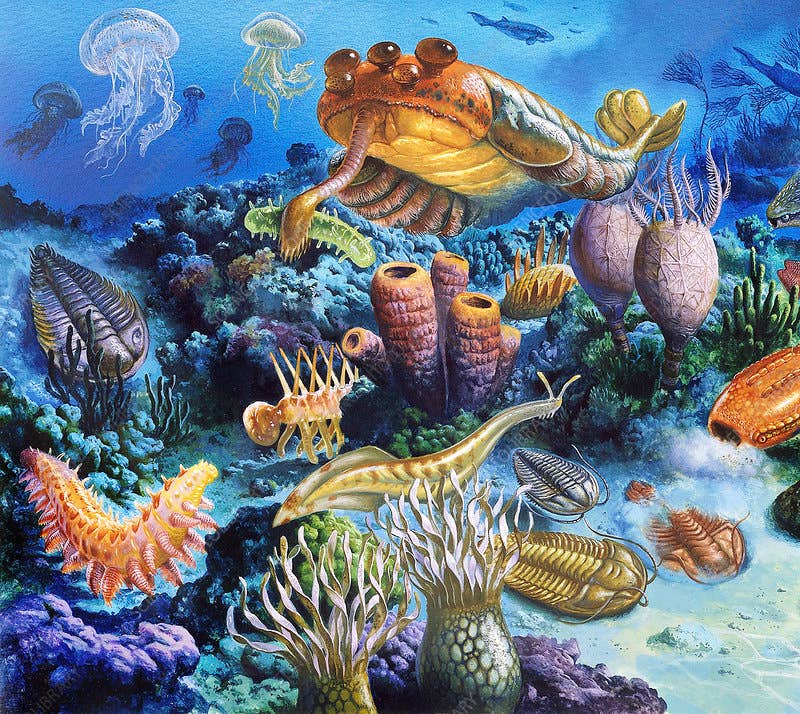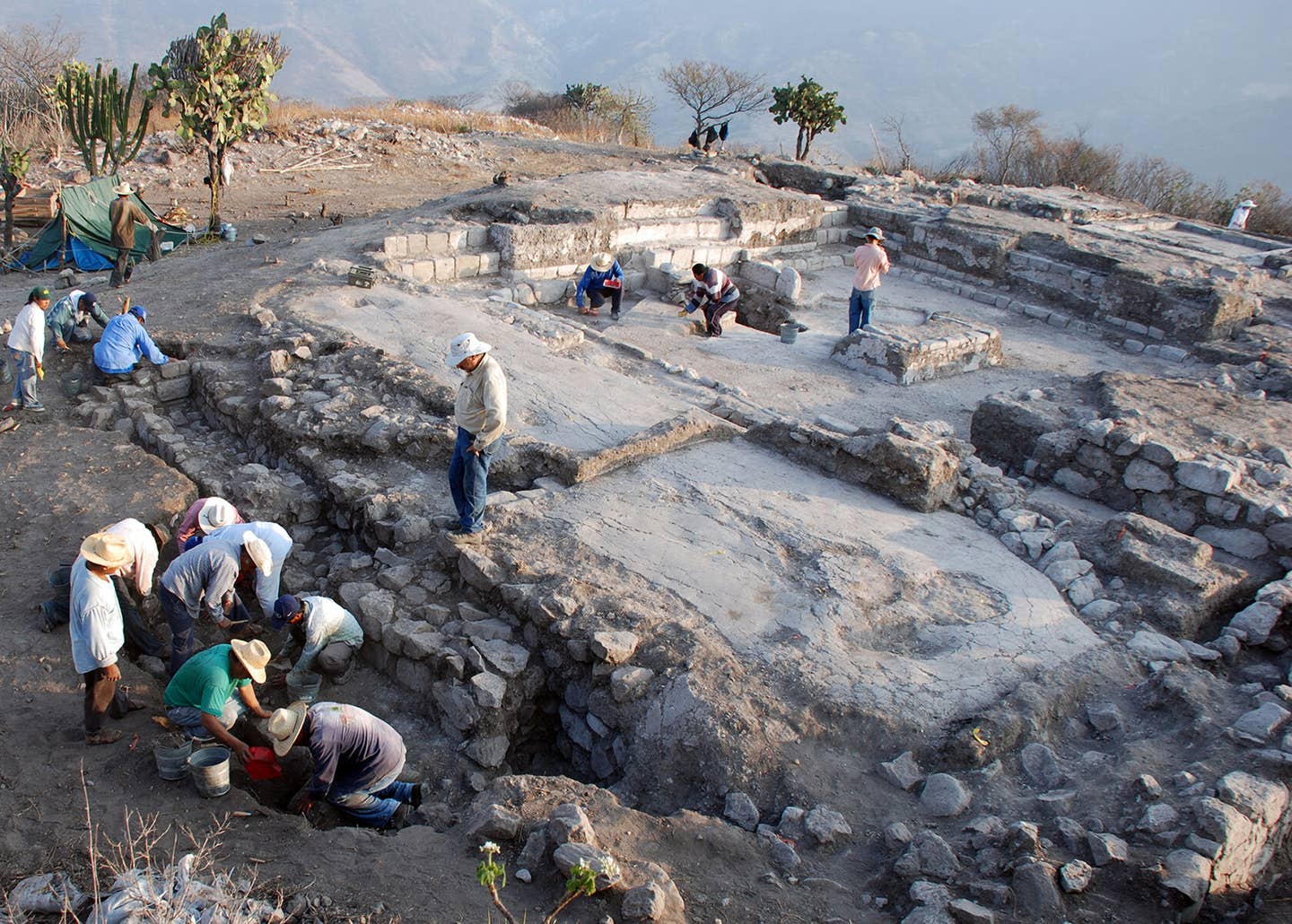Ancient fossils reveal signs of a prehistoric arms race
Fossil shells reveal the oldest evidence of an evolutionary arms race from over 500 million years ago in the Cambrian seas.

A fossil find in Australia reveals the oldest known evolutionary arms race, showing how early animals quickly adapted to survive deadly threats. (CREDIT: Christian Jegou, Science Photo Library)
In a quiet part of what is now South Australia, more than half a billion years ago, life was locked in battle. The ocean floor teemed with small shelled creatures trying to stay alive as newly evolved predators hunted them. A new study sheds light on this ancient struggle, revealing the earliest known case of what scientists call an “evolutionary arms race.”
This study, published in the journal Current Biology, explores how early animals adapted to survive as predators got better at attacking. For the first time, fossil evidence shows that prey didn’t just get eaten—they evolved to fight back. And so did the predators. Each change by one group sparked a response in the other. It was an endless contest for survival, and it happened quickly in evolutionary terms.
Fossils Tell a Story of Survival
The discovery comes from a group of researchers at the American Museum of Natural History, working with scientists from Australia’s University of New England and Macquarie University. Together, they studied over 200 fossilized shells from a tiny species called Lapworthella fasciculata. These animals lived about 517 million years ago during the Cambrian period.
The fossils were found in layers of rock that were once the seafloor. Some of the shells were just a bit bigger than grains of sand. Others were almost the size of apple seeds. Many of the shells had small, clean holes punched right through them.
To the researchers, this was no accident. The holes were too neat and too common to be caused by natural wear or simple damage. They were likely made by predators that specialized in drilling into hard shells. These unknown attackers were probably soft-bodied creatures, maybe worms or mollusks, with mouthparts built to puncture through armor.
“We're seeing evidence of a real back-and-forth here,” said Russell Bicknell, lead author of the study and a postdoctoral researcher in the Museum’s Division of Paleontology. “This is the first time we’ve been able to show clear evidence of prey directly responding to predation, and predators reacting in turn.”
The Cambrian Explosion’s Hidden Driver
The Cambrian period is famous for what scientists call the Cambrian Explosion—a time when animal life rapidly grew in variety and complexity. In just a few million years, many of the major animal groups that exist today first appeared. But what caused this sudden burst in life forms?
Related Stories
One long-standing theory points to predator-prey relationships as the spark. The idea is that as predators became better hunters, prey had to develop defenses to survive. This pressure pushed both sides to evolve new traits. Shells became thicker. Bodies became more mobile. Eyes, claws, and spikes all started to appear in the fossil record.
Until now, though, direct fossil evidence of this evolutionary arms race was scarce. Scientists had mostly relied on indirect clues, such as the appearance of shells or burrows. This study changes that.
Bicknell’s team didn’t just find pierced shells. They also saw something else: a steady thickening of those shells over time. By lining up the fossils by age, the team showed that the shell walls of L. fasciculata got noticeably thicker as the number of shell-piercing events increased.
This trend, which happened over a short geological window, strongly suggests that the shelled creatures were evolving stronger defenses in response to increased attacks. At the same time, predators were likely evolving sharper or more powerful tools to get through those defenses.
“This critically important evolutionary record demonstrates, for the first time, that predation played a pivotal role in the proliferation of early animal ecosystems,” Bicknell said. “It shows the rapid speed at which such phenotypic modifications arose during the Cambrian Explosion event.”
More Than Just Shells
The findings go beyond just fossils with holes. They help explain how life developed into complex ecosystems with a range of species performing different roles. Predators, prey, scavengers, and filter feeders each carved out a niche in early oceans. The constant struggle between hunter and hunted helped shape these roles.
An evolutionary arms race works like this: one species develops a new feature, like thicker shells. That gives it a survival advantage. But soon, a predator evolves a better way to crack those shells. So the prey must change again—perhaps by getting harder, faster, or smarter. The race never ends.
Scientists use the term “arms race” because this process mirrors how human nations build more powerful weapons to stay ahead of enemies. In nature, though, the weapons are built into the bodies of animals. And instead of engineers, evolution drives the design.
A Window Into Deep Time
The significance of this discovery goes far beyond ancient seas. It gives researchers a rare look into how natural selection worked during one of Earth’s most important periods. It also shows how fast life can adapt when survival is on the line.
By studying these small fossils, scientists now have a clearer picture of how animal behavior—especially the urge to eat and avoid being eaten—drove big changes in early life. These changes set the stage for the evolution of more advanced animals, including fish, reptiles, birds, and mammals.
It’s not just about ancient seashells. It’s about understanding the roots of biodiversity, the rise of ecosystems, and the ongoing role of adaptation in life on Earth.
This discovery helps fill a long-standing gap in evolutionary science. For decades, experts believed predator-prey dynamics played a key role in early animal evolution. Now, there's hard proof.
Note: The article above provided above by The Brighter Side of News.
Like these kind of feel good stories? Get The Brighter Side of News' newsletter.
Mac Oliveau
Science & Technology Writer | AI and Robotics Reporter
Mac Oliveau is a Los Angeles–based science and technology journalist for The Brighter Side of News, an online publication focused on uplifting, transformative stories from around the globe. Passionate about spotlighting groundbreaking discoveries and innovations, Mac covers a broad spectrum of topics—from medical breakthroughs and artificial intelligence to green tech and archeology. With a talent for making complex science clear and compelling, they connect readers to the advancements shaping a brighter, more hopeful future.



